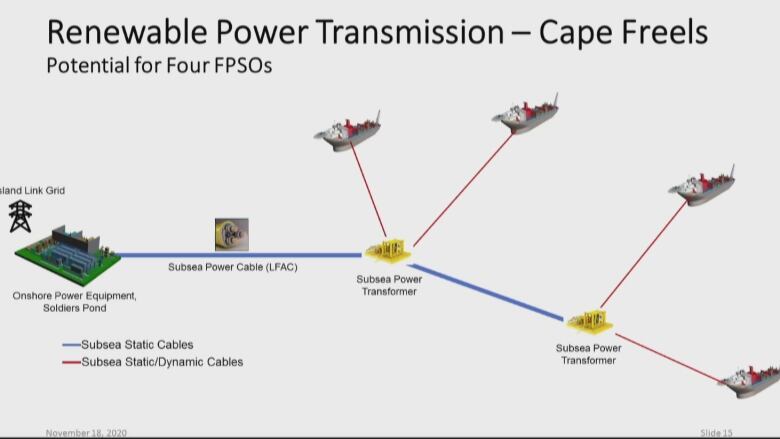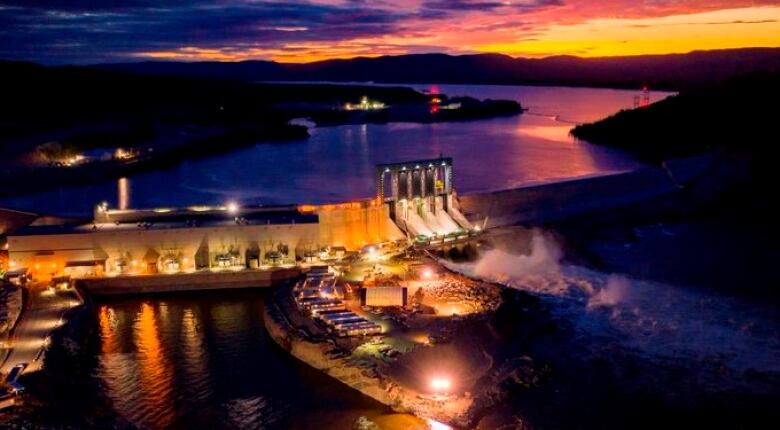Muskrat Falls could play a role in keeping N.L.'s offshore competitive in era of sustainability
A potentially supersize oil field in the Orphan Basin could be powered by hydroelectricity from Labrador

In an era where environmental considerations are becoming as important as costs to oil companies, the future of Newfoundland and Labrador's offshore industry could get a charge fromMuskrat Falls.
That was one of the scenarios laid out Wednesday during a virtual conference hosted by the province's oil and gas industries association, known as Noia.
With a theme of "Evolving Our Offshore: Balancing the Energy Mix," the conference featured speakers who focused on the challenges of remaining competitive in a sector that has slashed capital spending by an average of 30 per cent this year because of the COVID-19 pandemic, and with companies rushing to lower their carbon emissions in response to the changing climate.
The accepted leader in this new era is Norway, where half of the offshore developments in the North Sea on Norway's continental shelf are expected to be powered by shore-based renewable energy within the next decade.
Norway is already a world leader when it comes to carbon emissions per barrel of oil produced, and like Newfoundland and Labrador, has set a target of net zero emissions by 2050.

So in a strategy ripped straight from Norway's playbook, there's increasing chatter about how a potentially supersizeoil fieldone with the potential for between four billion and five billion barrels of recoverable oil,based on geoscience findingsin Newfoundland's offshore might be developed.
The prospect is called Cape Freels, and islocated in a frontier area known as the West Orphan Basin, some 350 kilometres northeast of St. John's. It has the potential to dwarf existing fields like Hibernia and Hebronin the Jeanne d'Arc Basin, andis one of 16 prospects identified through 3D seismic surveys with "significant" potential for future development, said Keating.
BP Canada Energy Group has acquired the rights to explore the prospect, and has been approved foran aggressive drilling campaign beginning as early as next year.
While any development is purely hypothetical at this stage, a company called Aker Solutions is studying the idea oftapping into excess electricity from the Muskrat Falls hydroelectric project in Labrador to power as many as four floating, production, storage and offloading vessels, known as FPSOs.

How would it work? With a very long more than 400 kilometres low-frequency, alternating-current power cord from the Soldiers Pond converter station on Newfoundland's Avalon Peninsula, delivering as much as 200 megawatts of electricity.
"That's an exciting opportunity," said Jim Keating, Nalcor's executive vice-president for oil and gasand acting president of OilCo, Newfoundland and Labrador's newly created, Crown-owned oil company.
Power generation can account for up to 85 per cent of carbon dioxide emissions from oil installations, and electrification is seen as the right strategy for decarbonizing the offshore.
Aker is also studying the viability of a similar electrification scenario for FPSOs off the coast of Labrador.
An oil field with zero emissions?
BP executives have talked openly about their intentions to aggressively lower the company's greenhouse gas emissions, and a Cape Freels development with zero emissions would fit nicely into that strategy, said Keating.
Muskrat Falls,part of the Lower Churchill project, includes an 824-megawatt power station on the Churchill River, and an 1,100-kilometre transmission line to the Avalon Peninsula.
The project is billions over budget andyears behind schedule, and was the subject of a public inquiry that found it was not the right choice to meet the province's future electricity needs.

But when the project reaches completion next year, oil industry supporters like Keating hope excess power from the project can be used to make Newfoundland's offshore a more attractive and competitive destination for oil companies.
With oil companies dramatically scaling back exploration, and existing fields in decline, experts are predicting a worldwide shortfall of up to 25 million barrels per day by 2030.
Keating says Newfoundland and Labrador is positioned to fill some of that gap, but only if companies like BP move forward with exploration projects.
"Even in our wildest dreams of a fairly robust offshore, which is going to bevery significant from our economic point of view, it kind of doesn't really make a dent into what the rest of the world is going to be looking for and anticipating," said Keating.

Wednesday's virtual conference occurred at a time of unprecedented shocks to the local and world oil industry, with one speaker saying the daily consumption of oil has dropped, on average, by 10 million barrels this year.
"That's the largest drop in oil demand in history," said Jo Husebye ofRystad Energy, pointing to the constraints imposed on travel by the COVID-19 pandemic.
Husebye said the pandemic appears to have accelerated the energy transition away from fossil fuels, with peak oil demand expected to be reached in the late 2020s.
He said that timetable could change if the switch to electric vehicles occurs quickly, since the transportation of people and goods represents up to 60 per cent of oil demand.
As such, Husebye expects the competition for oil investment will intensify, with projects that combine profitability and sustainability rising to the top.
He said regions like Newfoundland's offshore will compete with the shale oil industry in the United States for investment, since they have similar emissions and break-even points at oil prices just above $40 US.
But, he said, shale oil has one advantage: a shorterpayback period on investments.
"Payback time is a differentiator in the current environment," said Husebye.












_(720p).jpg)


 OFFICIAL HD MUSIC VIDEO.jpg)
.jpg)



























































































